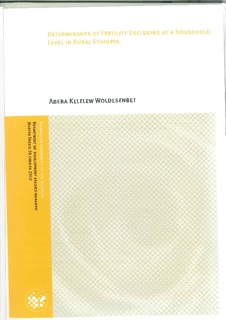| dc.description.abstract | High fertility has the potential to affect the health and well being of mothers and the survival of their children. Even though fertility in Ethiopia shows a declining trend at the national level, the onset of fertility decline is yet to come in rural areas. The main objective of this research is to identify major factors affecting the observed high fertility in rural Ethiopia. The study area was selected based on the Ethiopian demographic and health survey made by the Central Statistical Agency (CSA) in 2005. Analysis of the study is based on data collected from 81 household respondents, with the woman in her reproductive ages of 15-49 years, in the Alaje district of Southern Tigray-Ethiopia. Multivariate regression analysis is employed to identify major fertility determinants using Ordinary Least Squares (OLS) method. In-depth interview and discussions with the study subjects was also made to supplement the analysis. The regression results show that among the ten variables selected; ever use of contraception, parental perception of children as an old age security, land holding status, ideal number of children couples wish to have, and female literacy significantly affect fertility decisions at household level. These households, whose ideal number is small, where couples use contraception at least once, where women have some education, and hope will have their own economic means to support their old ages and have access to land tend to have reduced fertility than their counter- parts. The analysis also reveals that household income showed positive impact on fertility, and this aspect needs the attention of concerned authorities in their poverty reduction strategies. Moreover, the current study indicates that intermediate variables like age at first marriage and duration of breast feeding, and men’s education have minimal effect on fertility. The survey also reveals that reproductive health facilities are insufficiently addressed in the study areas. Hence, high governmental and health administration authorities’ commitment is vital to improve the health condition of mothers and children. Besides, socio-economic development accompanied with ideational change in favour of small family size is paramount to induce fertility transition in the study areas. | en_US |
